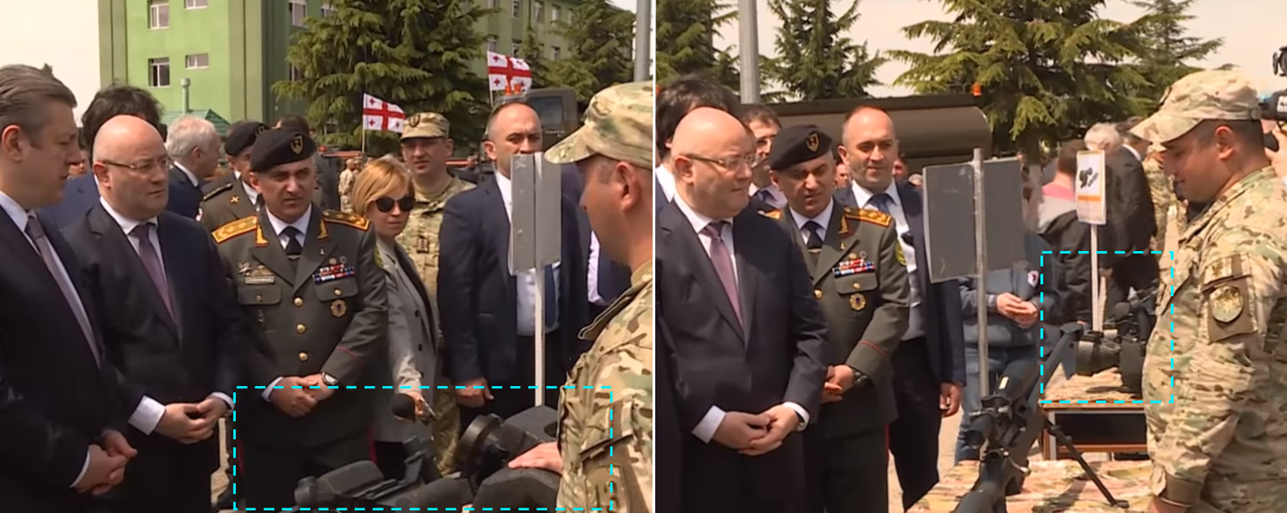
Georgia recently purchased the popular top-attack “Javelin” weapons amid concerns surrounding the transfer of the system to Ukraine

Ukraine has been in the spotlight this year in both Russian and western media for its controversial arms deal with the United States for Javelin Anti-Tank Guided Missiles (ATGM). Meanwhile, Georgia, a country in a situation somewhat analogous to that of Ukraine with portions its territory occupied by Russian-led “republics”, also bought and received Javelins without the same degree of attention.
While Javelins were reported to be in Georgia since January 2018, the system was only recently spotted in the country. On April 30, the Georgian Ministry of Defence (MoD) released footage of a military exhibition celebrating the 27th anniversary of the Georgian Armed Forces, with Javelin Command Launch Units (CLUs) on display.
@DFRLab has covered Javelin sales in an article earlier this year, detailing Russian and separatist reactions to the transfer of the weapons system to Ukraine. Estonia also received Javelins in early 2016.

Pictured above are three Javelin CLUs with Georgian servicemen. Satellite imagery confirmed that the exhibition took place at the southern part of Vaziani military base, located just east of the Georgian capital of Tbilisi. Georgia’s 4th Mechanized Brigade is based out of this military base.

The Deal
The U.S. Defense Security Cooperation Agency (DSCA) announced in November 2017 that the U.S. State Department had approved a deal for the sale of Javelin ATGMs to Georgia at an estimated value of $75 Million USD. The announcement read:
The Government of Georgia has requested to purchase four hundred ten (410) Javelin Missiles, and seventy-two (72) Javelin Command Launch Units (CLUs) (includes two (2) Javelin Block 1 CLUs to be used as spares). Also included are ten (10) Basic Skills Trainers (BST); up to seventy (70) simulated rounds; U.S. Government and contractor technical assistance; transportation; and other related elements of logistics and program support. The total estimated cost is $75 million.
In the implementation of this deal, a small delegation was sent to assist the Georgian military in effectively adapting the new systems.
Implementation of this proposed sale will require the assignment of approximately one (1) U.S. Government and two (2) contractor representatives to Georgia.
At a January 23 meeting, Georgian Minister of Defense Levan Izoria announced that the Javelin ATGMs had arrived in Georgia, and were being kept in a safe location as part of the first stage of the acquisition process.
U.S. Senator Rand Paul opposed this deal in December 2017 and introduced a joint resolution in the Senate “relating to the disapproval of the proposed foreign military sale to the Government of Georgia of Javelin Missiles and Javelin Command Launch Units.”
The proposed bill was intended to block the sale of Javelin ATGMs to Georgia, but did not come to fruition in time for the transfer.
Past Assistance
Georgia has been a longstanding U.S. strategic partner and historically controversial in its aspirations to join NATO due to conflicting Russian interests. These aspirations were further complicated in August 2008 with the outbreak of the Russo-Georgian War.
During this short war, it became apparent to the public that the U.S. had sold Bushmaster M4A3 automatic carbines to Georgia, as scores of them were left behind by the retreating Georgians and captured by Russian forces.

These rifles were part of one of the largest Georgian infantry procurement programs at the time, designed to make the Georgian military more compatible with NATO, which primarily uses similar AR-pattern rifles.
This procurement program was launched in January 2008, shortly before the outbreak of war, and aimed to replace AK-pattern rifles entirely with the Bushmaster M4A3s.
Russian Reaction
The Russian Ministry of Foreign Affairs commented on the sale of Javelin ATGMs in a press release on Deputy Foreign Minister Grigory Karasin’s meeting with co-chairmen of the Geneva Discussions on the South Caucasus.
The deputy foreign minister referred to the Javelin being part of deepening NATO cooperation with Georgia. Moreover, Karasin characterized this development as being “dangerous”. The press release then went on to state that “Russia believes this outside military support is directly encouraging Tbilisi to new dangerous adventures in the region.”
Conclusion
The sale of Javelin ATGMs to Ukraine and Georgia, though the latter recipient has received less publicity, represents what appears to be an expanding U.S. initiative to equip allied and partner nations with effective systems for defeating advancing armor.
Still, with Javelins becoming saturated across Europe, the Middle East, Caucasus, and beyond, the chance of these systems falling into the wrong hands increase significantly.
This sale also signifies continued U.S. and NATO commitment to the security of Georgia in an era marked by a resurgent and increasingly assertive Russia. Georgian forces have largely recovered and improved from the losses in 2008, but similar statements can be made for the Russian military, having undergone some of the most extensive reforms since the Soviet Union that same year.
Follow along for more in-depth analysis from our #DigitalSherlocks.

